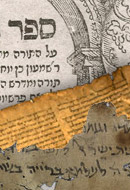Material World

When is a text not a text? When it is an object. When a Torah scroll is held up in the air so that congregants can view its columns of words, it is not being read. The words that the congregation chants—"And this is the Teaching that Moses put before the Israelites, at the command of the LORD through the hand of Moses"—are indeed found in the scroll, but in two different places. The first phrase comes from Deuteronomy 4:44; the second occurs four times in the book of Numbers (as well as once in Joshua). The combined sentence is not found in the Torah at all. In any case, it is not a statement of fact or a textual citation, but something quite different: a pledge of allegiance.
The importance of this sort of observation is the premise of a growing scholarly field that examines the "materiality" of texts: not just how new technologies (e.g., moveable type) change the ways texts are produced and read, but also the role the objects containing the texts—from scrolls to screens—play in the lives of those who encounter them. Harvard University and the University of Pennsylvania, and perhaps others as well, have ongoing seminars in "The History of the Book" to examine just such questions. Penn Press has a "Material Texts" series centered on this growing field of study.
Peter Stallybrass, the director of Penn's "History of the Book" seminar, was a fellow at Penn's Center for Advanced Judaic Studies (now the Katz Center) in 2001–2002. Though his work does not focus primarily on Jewish texts, his participation that year encouraged each of the other fellows to think about the material component of their own texts. Those seeds were planted in fertile soil; by now, studies on the materiality of text have established a solid foothold in Jewish studies.
This is a major change. Jewish scholars in the past, whether in religious settings or, since the 19th century, in the academic world, have been obsessed with the words of Jewish texts, sometimes even to the exclusion of the physical world described in those words. But newer studies are beginning to recognize that the words of a text do not convey its entire meaning. A recent book called Jewish Studies at the Crossroads of Anthropology and History, edited by Ra'anan Boustan, Oren Kosansky, and Marina Rustow, provides an opportunity to sample the new approach:
- In "Judaism and Tradition: Continuity, Change, and Innovation," Albert Baumgarten and Marina Rustow look at how the scroll, originally a standard medium for all texts, changed to a format "reserved as the vehicle for books that made special claims on tradition." Ironically, Torah scrolls containing all five books of the Pentateuch were unusually rare in the ancient world, perhaps existing in the Jerusalem Temple alone. Only one fragment of the Dead Sea Scrolls contains as many as three of the five books; only five contain as many as two. (It goes without saying that "the Teaching that Moses put before the Israelites" was not written in the same script as modern Torah scrolls. The Aramaic letter forms used today replaced the original paleo-Hebrew alphabet only in the middle of the first millennium B.C.E., a technological as well as a cultural change.)
- In "Words, Images, and Magic: The Protection of the Bride and Bridegroom in Jewish Marriage Contracts," Shalom Sabar looks at the ketubah not in its contractual aspects but as "an object with a conspicuous physical presence." Maimonides notes that if a woman is not in physical possession of her marriage contract, her husband is not allowed to spend "a single hour" with her. It is the object, not the words of the agreement, that is paramount. The designs that accompany the language of the text, too, are not merely esthetic. They also reveal the preoccupations and cultural connections of the Jews who create or purchase the ketubot containing them. (The tradition of drawing in the stem of a ק just before the signing of the ketubah—so the contract can be said to have been written at the time of the ceremony—is another aspect in which materiality trumps content.)
- In "Prayer, Literacy, and Literary Memory in the Jewish Communities of Medieval Europe," Ephraim Kanarfogel uses the lens of a talmudic statement—that verses from the written Torah may not be recited from memory but must be read from a text—to examine everything from levels of literacy through the availability of prayer books to the logistics of synagogue lighting. (In this case, materiality also opens a window on spirituality.)
Work of this kind is beginning to shed light not just on the major thinkers of the Jewish past but on the ways in which the lives and practices of ordinary Jews have changed through the ages. Some, no doubt, will take advantage of this new field to avoid the hard work of philology and history that serious scholarly examination of texts entails. But those skills remain essential if studies of the materiality of texts are to prove fruitful. If the recently announced Afghanistan genizah scrolls are authenticated, textual scholars of the first rank will be needed to interpret them—not just as texts, but as objects too. If the studies described above are any indication, Jewish scholars are ready for the task.
Michael Carasik is the creator of The Commentators' Bible and of the Torah Talk podcast. He teaches at the University of Pennsylvania.
Comments are closed for this article.




